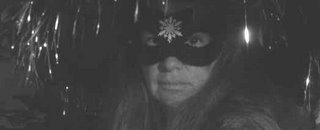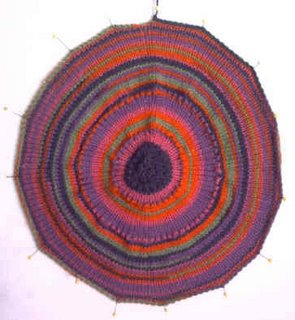31 October 2006
25 October 2006
Circles Round III -- Time for pi
 When I wrote that the pi example was at 144 stitches on round 22 I mistyped and should have said round 22 of plain knitting with 144 stitches on the needle.
When I wrote that the pi example was at 144 stitches on round 22 I mistyped and should have said round 22 of plain knitting with 144 stitches on the needle.The pi shawl is not as dependent on the number of stitches you begin with or how you arrange the increases. That's what makes it so simple and yet effective.
EZ's pi shawl:
Cast on 9 stitches divide evenly onto three needles, join, do not twist, knit with a fourth needle.
Round 1: knit
Round 2: (YO, K1)3x on each needle (9 times total) = 18 stitches 6 per needle
Knit 3 rounds plain
Round 6: (YO, K1)6x on each needle (18 times total) =36 stitches 12 per needle
Knit 6 rounds plain
Round 13: (YO, K1)12x on each needle (36 times total) = 72 stitches 24 per needle
Knit 12 rounds plain
Round 26: (YO, K1)24x on each needle (72 times total) = 144 stitches 48 per needle
Knit 24 rounds plain Round 51: (YO, K1)48x on each needle (144 times total) = 288 stitches 96 per needle
Continue as established doubling the total number of stitches in each increase round and doubling the number of plain rounds between the increase rounds.
With 24 rounds of stocking stitch, I am not surprised that it curls up much more than the other circles but I was surprised that it really didn't want to lie flat without considerable coaxing.
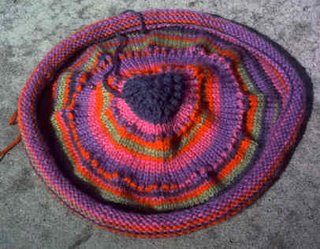 In addition to the pi shawl, EZ's Knitting Almanac describes the spoke shawl which she describes as being formed with double increases (YO, K1, YO) at seven points every 4th row. After a detour to discuss Mary Thomas's Disc Medallion we'll take a look at the spoke shawl.
In addition to the pi shawl, EZ's Knitting Almanac describes the spoke shawl which she describes as being formed with double increases (YO, K1, YO) at seven points every 4th row. After a detour to discuss Mary Thomas's Disc Medallion we'll take a look at the spoke shawl.23 October 2006
Circularly Speaking -- Round I & II
I didn't include circles in the original polygon seminar because, technically/geometrically speaking, circles aren't polygons. Still, lots of circular medallions originate as polygons that are blocked into circles.
In reviewing my polygon notes, it would appear that I explained both but only knit one of the two geometric octagons so I'm going to revisit that shape and see about correcting my omission both here and on the web page.
Knitted circles and knitted octagons have rather a lot in common. At the outset, with the exception of EZ's pi shawl method (which starts with 9), the octagons and circles that we'll be exploring begin with 8 stitches and double to 16 total stitches at the end of round 2. From that point on things change a bit with each method taking a slightly different path but they all form a circle.
Mary Thomas suggests three ways to knit a circle -- the radiant, the disc and the target. EZ (Elizabeth Zimmermann for the not knitwise) covers circles in the following shawls: the pi, the spoke shawl (with two variations) and the inner directed shawl.Joan Schrouder's excellent Shaping shawls handout (class highly recommended) covers some other circles as well.
References:
Mary Thomas's instructions for polygons and circles can be found in Mary Thomas's Book of Knitting Patterns copyright 1945
EZ's pi shawl instructions can be found in Knitter's Almanac, copyright 1974
EZ's pi squared shawl instructions can be found in Knitting Around copyright 1989
 First up is the Radiant circular medallion with increases that seem to radiate from the centre.
First up is the Radiant circular medallion with increases that seem to radiate from the centre.
This example, like all others was knit on size 2 US (2.75mm) needles with left over Regia Crazy Stripes. To make the pattern of increases easier to see, the yarn over increase method was used to make all increases. Any other type of increase can also be used.
Cast on 8 stitches,
divide evenly onto four needles,
join, do not twist, knit with a fifth needle.
Round 1: knit
Round 2: increase into every stitch (16 total -- 4 per needle)
Round 3, 4 & 5: Knit
Round 6: increase into every stitch (32 total -- 8 per needle)
Round 7, 8 & 9: Knit
Round 10: (K1, increase 1)16x (48 total -- 12 per needle)
Round 11, 12 & 13: Knit
Round 14: (K2, increase 1)16x (54 total -- 16 per needle)
Round 15, 16 & 17: Knit
Round 18: (K3, increase 1)16x (80 total -- 20 per needle)
Round 19, 20 & 21: Knit
Round 22: (K4, increase 1)16x (96 total -- 24 per needle)
Round 23, 24 & 25:
Round 26: (K5, increase 1)16x (112 total -- 28 per needle)
Round 27, 28 & 29: Knit
Round 30: (K6, increase 1)16x (128 total -- 32 per needle)
Round 31, 32 & 33: Knit
Continue as established, knitting one additional stitch before increasing in the increase rounds and working 3 plain rounds between each increase round.
Note: whether you increase in the stitch (knit into the front and back) or increase before the stitch with a YO or M1, do not count the stitch when counting out to your next increase. Thus, round 6's (K1, increase 1)16x can be interpreted as (K1, Kf&b)16x, (K1, M1, K1)16x or (K1, YO, K1)16x
 The example, was knit up to round 29 (112 stitches) before binding off.
The example, was knit up to round 29 (112 stitches) before binding off.
Next is the Target circular medallion.
 Mary Thomas's Target is very much like the pi shawl up until round 20 when instead of doubling the stitches and number of non-increasing rounds the increase rounds increase by 32 stitches with five non-increasing rounds before each increase round.
Mary Thomas's Target is very much like the pi shawl up until round 20 when instead of doubling the stitches and number of non-increasing rounds the increase rounds increase by 32 stitches with five non-increasing rounds before each increase round.
It is knit as follows:
Cast on 8 stitches,
divide evenly onto four needles,
join, do not twist, knit with a fifth needle.
Place markers after every 2 stitches.
Round 1: knit
Round 2: increase into every stitch (16 total - 4 per needle)
Round 3, 4 & 5: Knit
Round 6: increase into every stitch (32 total - 8 per needle)
Round 7, 8, 9, 10 & 11: Knit
Round 12: increase into every stitch (64 total - 16 per needle)
Round 13, 14, 15, 16, 17, 18 & 19: Knit
Round 20: increase into every 2nd stitch (96 total - 24 per needle)
Round 21, 22, 23, 24 & 25: Knit
Round 26: increase into every 3rd stitch (128 total - 32 per needle)
Round 27, 28, 29, 30 & 31: Knit
Round 32: increase into every 4th stitch (160 total - 40 per needle)
Round 33, 34, 35, 36 & 37: Knit
Round 38: increase into every 5th stitch (192 total - 48 per needle)
Beginning with round 6 increase by 32 stitches each round and knit 5 plain rounds between increase rounds. Beginning with round 20 knit one additional stitch before increasing.
 The example was knit up to round 31 (128 stitches) before binding off. The Regia Crazy Stripes
The example was knit up to round 31 (128 stitches) before binding off. The Regia Crazy Stripes
was augmented with some green Baby Ull.
I've got a pi example on the needles now with 144 stitches on round 22.
18 October 2006
Eeek an update
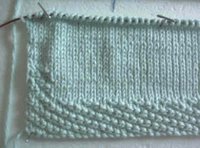 The pentagon sleeves project 's switch yarn every row plan is working out and front and back are now about 7 or 8 inches long. That's roughly the length in the photo from late July when I discovered the dye lot problem. Although I may still have made a few mistakes along the way I'm okay (no, no, really) with the way the dye lots are blending and I'm forcing myself to at least start the next row when I'm doing the second knit or purl row. That keeps me from having the which end now question.
The pentagon sleeves project 's switch yarn every row plan is working out and front and back are now about 7 or 8 inches long. That's roughly the length in the photo from late July when I discovered the dye lot problem. Although I may still have made a few mistakes along the way I'm okay (no, no, really) with the way the dye lots are blending and I'm forcing myself to at least start the next row when I'm doing the second knit or purl row. That keeps me from having the which end now question. The recent cooler weather and a bit of calendar shock made me haul out another long languishing project -- the DNA scarves that were originally slated to be Christmas presents in 2005. Since procrastination runs in the family, it's no surprise that they didn't get done on time. The length of the scarves makes them awkward for walkabout knitting and a weather change will probably sideline them but progress is being made.
The recent cooler weather and a bit of calendar shock made me haul out another long languishing project -- the DNA scarves that were originally slated to be Christmas presents in 2005. Since procrastination runs in the family, it's no surprise that they didn't get done on time. The length of the scarves makes them awkward for walkabout knitting and a weather change will probably sideline them but progress is being made.Speaking of progress, here's a shot of the latest local construction project looming in the 'hood.

03 October 2006
Pentagon problems or I guess I'm pickier than I thought
Then I meticulously tinked (unknit, took out note that the term is knit spelled backward) back to the marked area on one of the sides. I put the knitting aside with a note of where I was in the pattern and secure in the knowledge that I had alternated the yarn so any variation was from the difference in dye lots and not a failure to swap on my part.
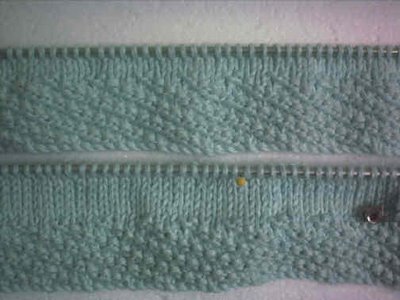 Even though the striping bothered me, I noted in my design journal that "I'm not picky (or am I?) enough to slip/knit to blend." I decided that the stripe was a difference that I could live with and that even the change every row rather than every other row was too much of a hassle of tangled yarns.
Even though the striping bothered me, I noted in my design journal that "I'm not picky (or am I?) enough to slip/knit to blend." I decided that the stripe was a difference that I could live with and that even the change every row rather than every other row was too much of a hassle of tangled yarns.On Friday I got home from work early enough to put in about four or five miles of walkabout knitting, so I soldiered on knitting the pentagon sleeve project. Maybe it was the fading light of day or denial but I almost convinced myself that from a distance it would look much more blended.
 Come the harsh light of Saturday morning, I couldn't really escape the fact that the striping bugs me, really, really bugs me.
Come the harsh light of Saturday morning, I couldn't really escape the fact that the striping bugs me, really, really bugs me.The photos might not show the stripe and other knitters might not see or be bothered by the stripes but I can't live with them.
The biggest problem is that I keep thinking that I've made a mistake and since most of my knitting time is a catch as catch sort of business, I can't really have a project where I'm seeing and trying to correct phantom errors.
While I still don't think that I'm quite picky enough to slip/knit each row through the body of the front and back, I'm coming round to the conclusion that I'll have work one side at a time and alternate every row to get a blend of dye lots that isn't jarring to me.
I started to write drive me to distraction but the fact is that problems with the pentagon are part of what has helped drive me to the other knitting distractions. So while I'd like to get the pentagon back on track, I'm putting it on the back burner yet again.
Saturday's walkabout knitting ended up being a combination of three of my could be commitment problem projects. All involve bias knitting which is pretty straight forward and all have design dilemmas/decisions looming.
When I finally did make it out the door on Saturday, I opted for the Park Boulevard to Presidents Way route that adds about an extra mile or so to my usual circle the park stroll.
The Frontrunners' web site has running and walking resources for San Diego county including one route that takes you over six different pedestrian bridges in one go and logs 10 miles. Unfortunately, as of today, the routes page on their site has a lot of broken links for the walking and running routes but the site is still a good resource and I'm confident that the broken links will get fixed soon.
I've recently written about two of the six bridges and since the Park Boulevard route covers one of the others, and touches on another, I thought I'd throw them into the walkabout route mix.
Of the six pedestrian bridges, two span canyons, two span roads and two span freeways. The canyon spanning bridges are the Quince & Spruce street bridges. Saturday's walk covered two more bridges spanning a road and a freeway.
The first bridge is a hide in plain sight sort of affair that spans Park Boulevard and connects Plaza de Balboa (by the Natural History Museum & Reuben H. Fleet Space Centre) with the desert and rose gardens to the East.
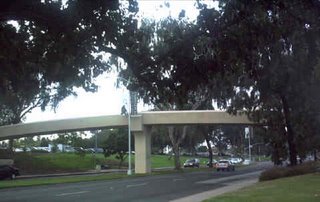 Beginning at the Hillcrest sign, head East on University, South on Park just past Village Drive, follow the pavement to the right toward the plaza before turning left onto the bridge to cross Park Boulevard. To the left is the desert garden and to the right the rose gardens.
Beginning at the Hillcrest sign, head East on University, South on Park just past Village Drive, follow the pavement to the right toward the plaza before turning left onto the bridge to cross Park Boulevard. To the left is the desert garden and to the right the rose gardens.Continuing South on the East side of the street, pass the Naval Hospital and the Balboa Park Activity Centre (including the gym and the administration Building) on your left.
In the large parking lot area just South of the Veteran's Museum and Memorial Center visitors to Balboa Park can find both free parking and a free park tram. This area is called Inspiration Point and it is the gateway to the second bridge of the day, the one that spans six lanes of the I5 about 15 miles North of the international border with Mexico.
 The North end of the bridge begins at the Southeast corner of the parking lot, with this vine covered entrance.
The North end of the bridge begins at the Southeast corner of the parking lot, with this vine covered entrance.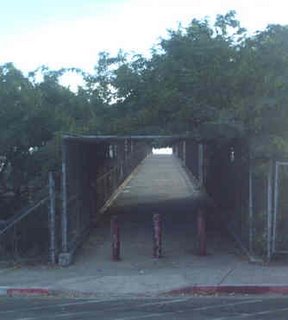 At the other end the walkway spirals down and provides a view back at the bridge, freeway & off ramps before ending in a parking lot by a sports field of San Diego High School.
At the other end the walkway spirals down and provides a view back at the bridge, freeway & off ramps before ending in a parking lot by a sports field of San Diego High School.
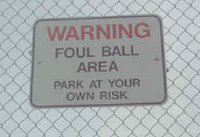 If a game's in progress, give the fence and the reserved faculty parking spots wide berth as the bridge ends in a foul ball zone.
If a game's in progress, give the fence and the reserved faculty parking spots wide berth as the bridge ends in a foul ball zone.I almost always get a bit turned about once I cross the bridge this way and find myself wandering the maze of campus parking lots. Since it was a Sunday with sunset approaching, I opted to cross the bridge back across the 5 and finish the day's walk by crossing
Park, and following Presidents Way into the park and out the Prado/Laurel Street Bridge over the 163.
The bridge's usually great views were somewhat obscured with the banners of the next day's AIDs walk sponsors. Pass the Lawn Bowls courts, cross Balboa Drive and go North on 6th to Upas. West on Upas, North on 5th ending at the Hillcrest sign -- estimated mileage = 5.5 miles.
